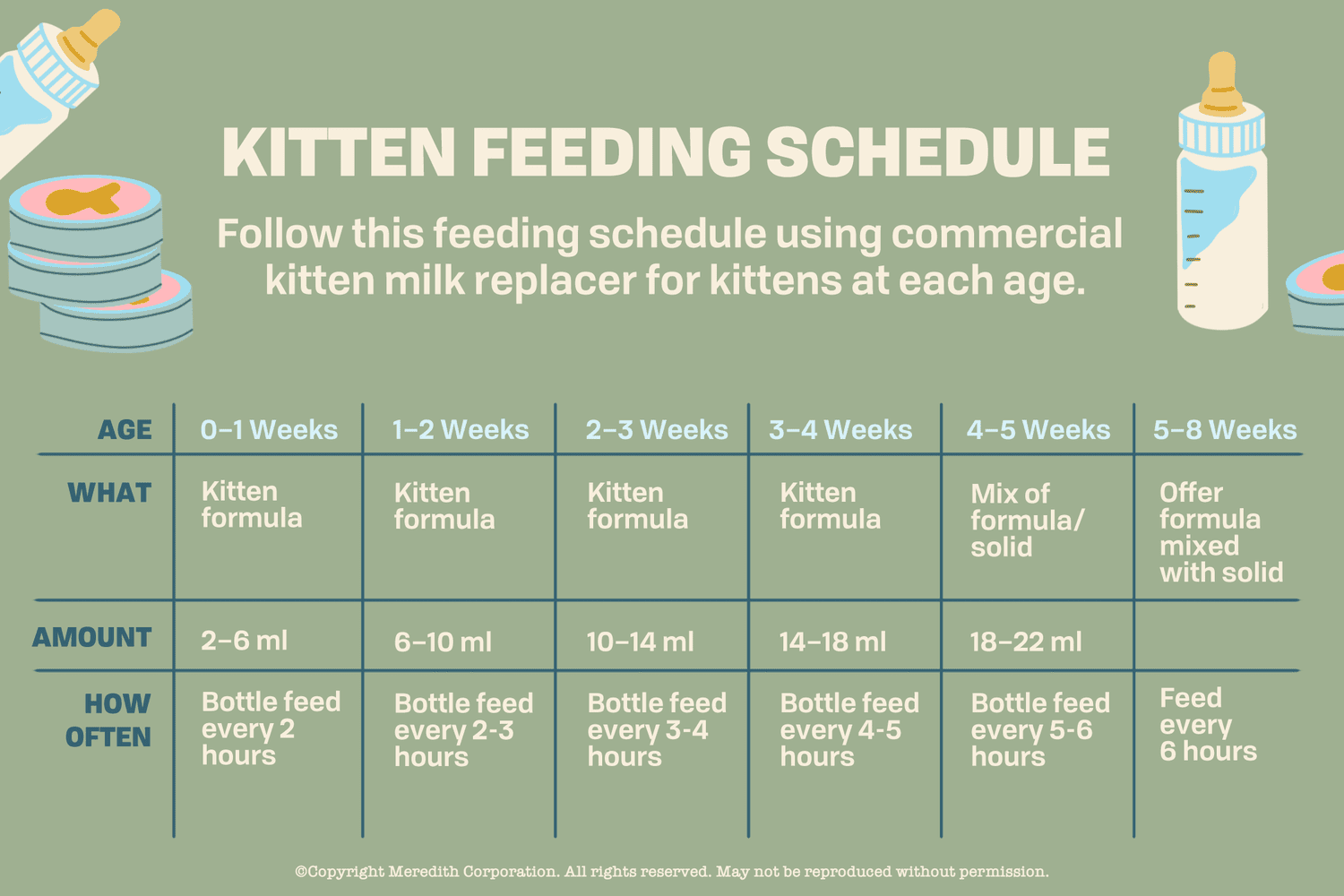
How To Bottle Feed Kittens
ASPCA Approved Bottle-Feeding Techniques
• Sanitize hands.
• Place kitten (one at a time) on a stable surface, covered with a soft towel or bedding, and a clean pee pad.
▪ It may be beneficial to warm up the towel/bedding (in a dryer or microwave) so that it is warm to the touch but not hot, before placing the kitten on it for feeding.
• Open the mouth gently with the tip of your finger and slip the bottle nipple in. Once your kitten gets comfortable with the bottle, they will search out the nipple enthusiastically. You will feel a “vacuum effect” when the kitten gets into suckle mode. If the kitten is suckling, you will see the ears pulsing back and forth with each swallow as the mouth creates a vacuum around the bottle.
• To keep air from getting into the kitten’s stomach, hold the bottle at a 45-degree angle, keeping a light pull on the bottle.
▪ Keep the kitten comfortable and ensure they don’t strain their necks too much while nursing.
▪ If a kitten refuses to take the nipple or won’t suckle, stop offering the bottle. Try massaging them on their forehead and stroking their back. Take a new toothbrush and stroke the kitten’s back with it. This replicates the activity of a mother cat’s cleaning and can effectively stimulate a kitten to nurse.
▪ Is the kitten cold when you handle them? If they are, please place them on the heating source. A hypothermic kitten will show no interest in bottle-feeding.
▪ Sometimes kittens will not latch if their belly is already full. If this may be the case, you can attempt to assist with elimination before offering the bottle. (see the stimulating section)
▪ Is the bottle too cool? Kittens may not latch if this is the case; warm the bottle between feedings so that the milk is the temperature of your skin.
▪ Sometimes kittens are picky or have trouble latching the first time; it is a learning process for them to drink from a bottle.
• When a kitten has had enough formula, they will usually unlatch from the nipple on their own, and their tummy will be very rounded, almost pear-shaped.
▪ When bottle feeding is complete, bottles must be washed and sanitized.
When bottle-feeding, remember not to:
▪ Overfill the bottles and waste milk.
▪ Squeeze the bottle; this may cause milk to flood into the kitten’s mouth.
▪ Force-feed milk or water; young kittens do not have a gag reflex.
▪ Feed kitten vertically, standing up, on or on their backs.
▪ Feed milk that is too hot. (It should be the temperature of your skin.)
▪ Be impatient.
A typical, successful feeding session may take about 5-10 minutes, per kitten.
Feeding Completion and Wrap-up
• Repeat all steps until all kittens in the litter are fed.
• Assist all kittens with elimination after feeding. (See Stimulating section.)
• Clean all kittens’ faces and bodies with clean, warm, damp gauze or washcloth. Ensure they are not wet, just clean. • Discard any unused formula in the bottles and thoroughly disinfect all parts.
▪ Do not place bottles or nipples in a dishwasher – hand wash only.
▪ Using hot water and dish soap, use the small bottle brush to fully clean the inside of the bottle(s) and the nipple(s).
▪ Rinse very thoroughly to ensure there is no soap or milk residue in the bottle(s) or nipple(s); this prevents the development of bacteria, which could be harmful to your kitten.
▪ Air dry between feedings.
Stimulating
Kittens this age do not know how to urinate or defecate on their own. It is natural for mother cats to lick the back end of their babies to stimulate the bowels and bladder. Since our bottle feeder kittens are not with their mother, foster caregivers must assist with this before and after every feeding session.
• Before and after feeding the kitten, gently rub a warm, damp cotton ball or cloth on their genital and anal areas using a front-to-back motion with gentle pressure until they eliminate. You may also employ a gentle “tapping” technique.
• Once the kitten has finished eliminating, stop rubbing. Overstimulation will irritate the area. Be mindful to watch for and avoid any chafing.
• Kittens should urinate at every feeding, and almost always during stimulation.
• Kittens should defecate about once a day. It may take a couple of feedings to see results, so don’t despair if the kitten doesn’t defecate right away.
• Always record your kitten(s)’ elimination on a health monitoring log.
Temperature Regulation
Kittens this small are unable to regulate their body temperature on their own. To help keep them warm, you can use a heating disc or hot water bottle to provide proper heat support. To heat the disc, microwave for 5 minutes and it should last for 6-8 hours. Always wrap the disc with a pee pad or blanket. If a kitten touches the disc unwrapped, it could potentially burn their paw pads. If you don’t have a microwave, you can use a hot water bottle instead.
Important to Note
Kittens that are not consuming the correct amount of nutrition as outlined in these instructions are likely to become underweight, lethargic, and dehydrated, which could result in death. Foster Caregivers must closely monitor the kittens in their care. Some kittens will not latch onto the bottle. Kittens rely heavily on scent and instinct – and a mother – to guide them. Always attempt to let the kitten eat on their own from a bottle first.
Preparing Formula
Use approved, kitten formula.
1. Add one part powder to 2 parts warm water (100°F) using a clean scoop. ▪ Using tap water is acceptable, but if your household water supply has a high chlorine or mineral content it may be preferable to use filtered water (home filtered or store-bought). If store-bought, ensure it is safe for drinking (e.g., not distilled).
2. Mix until well blended with no lumps. Do not shake as it will cause air bubbles to mix in.
3. Mixed formula must be refrigerated and used within 24 hours. ▪ Please label all containers of mixed formula with the date/time the formula was made and discard any formula older than 24 hours. ▪ You may wish to prepare enough for one full day’s feeding to keep in the refrigerator for use; remember to discard any excess that is not used.
4. Place bottles into a warming source to maintain their temperature until feeding. Milk should be around the same temperature as your skin.
5. For bottle warming, do not heat the actual bottle. ▪ Use hot water in a container, rest bottle in it and continuously dip/warm during feeding sessions. ▪ Test on your wrist by feeling the bottle; make sure it’s not too hot. Positioning Kittens for Feeding
This step is very important and is where the crucial surrogate bonding happens. Kittens are most comfortable in a position similar to the one they’d be in if they were nursing from a mom cat. Never cradle them on their backs, like one would a human baby. The on-the-stomach position prevents formula food from entering the windpipe which causes aspiration pneumonia.




